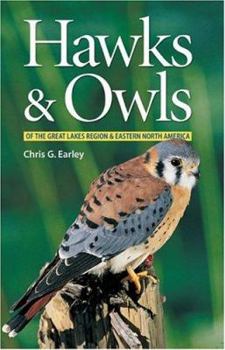Hawks & Owls of the Great Lakes Region & Eastern North America
Select Format
Select Condition 
Book Overview
Birds of prey can be particularly difficult to track for a variety of reasons: - Nocturnal behavior - Remote habitats - Migratory patterns - Swift flight speeds Hawks and Owls depicts both the subtle... This description may be from another edition of this product.
Format:Paperback
Language:English
ISBN:1552978478
ISBN13:9781552978474
Release Date:March 2004
Publisher:Firefly Books
Length:128 Pages
Weight:0.70 lbs.
Dimensions:0.4" x 5.5" x 8.5"
Customer Reviews
3 ratings
Not only for beginners.
Published by Thriftbooks.com User , 18 years ago
The excellent quality of this field guide matches others by Chris Earley. Being able to study the large, clear, color closeups of these species will enhance your identification skills. Seasonal range maps, special notations, calls and sounds made, plus additional comparison charts in the back make this another must have. It's lightweight, easy to carry and worth adding to your collection of field guides!
Excellent Guide for the Beginner
Published by Thriftbooks.com User , 19 years ago
Birds of prey are regarded with particular fascination by many birders, but their identification presents a number of problems that can daunt the beginner. Hawks & Owls of the Great Lakes Region and Eastern North America, therefore, is an excellent introductory guide. Each species has between two to four pages devotes to it. The majority of this space consists of photographs, depicting the species in flight and perched; save for a few, the photographs are crisp and clear. Aside from the brief introductory note and the more brief "nature notes," text is devoted to pointing out key features of the given species. Size, characteristics while perched and in flight, differences between males, females and juveniles, flight traits, and distinguishing calls are dealt with for each species, while relevant information concerning morphs and second year plummage, etc. is included when applicable. Overall, I'm very impressed by this guide and highly recommend it to the beginning birder.
A Welcome Addition to a Crowded Field
Published by Thriftbooks.com User , 19 years ago
A lingering perk: Some publishers still have my name listed as editor of the NAFA Hawk Chalk. Evidently Firefly Books is one, and I'm thankful for that. Some very good natural history and reference titles are available from this company, and they recently sent me one for review.Chris G. Earley (the Canadian biologist who produced similar regional guides to sparrows & finches, and warblers; both titles with Firefly) makes an excellent addition to the growing list of photographic guides to North American raptors. There are some heavy hitters in this field already (e.g., Clark and Wheeler's 1995 guide and subsequent editions), which raise the bar for any newcomers. But Earley's concise volume is well constructed and worth adding to any falconer or birder's library. Earley presents the raptors (diurnals first, then the owls) in their basic taxonomic groups or genera. He opens with a brief discussion of the guide's conventions (size comparisons, the standard icons he uses for quick reference, etc.) and good, basic advice for hawk watchers (to wit: watch the hawk first, as long as you can, then look it up). He completes his introduction with diagrams of avian anatomy as they relate to field identification, adding notes on common "hawk look-alikes" and a chart for best raptor viewing by season and species.The following species accounts are brief, each covering two to four pages with large, well-composed color photos illustrating. A short note on natural history is typically accompanied by viewing and ID tips (some include literary quotes), and capped with the book's standardized set of icons and field notes. The author's selection of images is especially helpful, with color morphs and age-appropriate plumages displayed in easy-to-compare views. It is noteworthy that unlike some of the less qualified sources of raptor photo ID (especially those on the Web), the Cooper's hawks shown herein are actually Cooper's hawks; the Sharp-shins actually Sharp-shins. One particularly fine image (by Brian Wheeler) shows an adult male and female Cooper's standing together and dramatically captures their size dimorphism.Earley closes this small volume with notes on how the public may help and observe raptors in their area, some suggested reading and a very helpful photographic "summing up" of included species that allows, via a series of charts, direct comparisons of similar species: the accipiters to each other, buteos to other buteos, and so on, which saves the reader the task of flipping pages to note the differences. Of course, I happily flipped between the pages anyway.





